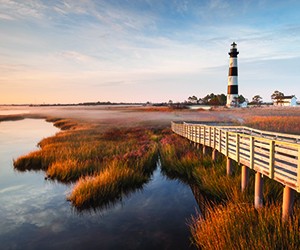Last October, after first wreaking havoc across the Caribbean, Hurricane Matthew threatened continuing destruction in at least five Southeastern states, including South and North Carolina. Ultimately, Matthew tracked close to but away from the coast, which Weather Channel meteorologist Ari Sarsalari called “just about the best-case scenario” in avoiding an “epic disaster.”
Still, the coastal Carolinas and their neighbors incurred coastal and inland flooding, beach erosion and significant infrastructure and property damage from heavy rainfall and wind gusts. In terms of business impact, leading hospitality industry analytics firm STR estimated some $50 million in net hotel room revenue loss in Florida, Georgia, the Carolinas and Virginia. Citing comparable impact to 2012’s Hurricane Sandy, STR projected higher overall losses “once you factor in future lost business as a result of the extensive damage and renovations that many hotels will require prior to reopening.”
How did the coastal Carolinas fare? Remarkably, several group destinations experienced minimal business interruption, and while more impactful for others, all reported a generally swift return to business and recovery of lost opportunities, with new hotels and “grand” future developments contributing to a buoyant overall outlook.
NORTH CAROLINA
Located just inland at the southern end of North Carolina’s coast, historic Wilmington, its downtown running nearly two miles along the Cape Fear River and encompassing the coastal towns of Carolina Beach, Kure Beach and Wrightsville Beach, felt no significant impact from Matthew. In fact, on Oct.10, the day after the hurricane moved away from North Carolina and out to sea, Wilmington hosted some 125 conventioneers of the North Carolina Chapter of the American Public Works Association.
“We were very fortunate to be welcoming visitors shortly after the storm passed,” said Connie Nelson, communications and public relations director for the Wilmington and Beaches CVB. “Most flooding occurred in rural areas about an hour inland. The North Carolina Department of Transportation responded quickly by setting up detours around the affected areas that provided safe travel to Wilmington.”
With all major routes leading into Wilmington subsequently restored, the city and beaches resumed their busy fall calendar with a run of October and November events that included the Carolina Beach Marathon, PPD IRONMAN North Carolina Triathlon, N.C. Surf to Sound Challenge (stand-up paddleboard competition) and Seaside Soccer Classic, a regional annual tournament bringing 2,100 youth soccer players and their families to the destination. Plus, conventions, military balls and other robust business.
“Wilmington and our island beaches continue to welcome coastal meetings, conventions and events with excellent facilities and Southern hospitality, not to mention glorious sunrises on east-facing beaches and spectacular sunsets along the Cape Fear River,” said John Sneed, vice president of sales and services for the Wilmington and Beaches CVB.
Located inland from the central North Carolina coast along the Trent and Neuse Rivers, historic New Bern and Craven County were impacted by Matthew, but quickly bounced back.
“Along with losing infrastructure, homes and businesses, we experienced negative economic impact from the loss of tourists, conventions and events scheduled for October,” said Melissa Riggle, tourism and sales service executive for the New Bern-Craven County Convention & Visitors Center. “Working together, however, we were able to re-book our convention groups and lost business, and reschedule our largest festival of the year, MumFest. Our success in rallying after this catastrophic storm shows our community spirit and that everything truly comes together here in New Bern.”
Forming an arc of south-facing towns and beaches along 85 miles of coastline below New Bern, the Crystal Coast experienced no damage from the hurricane, reported Crystal Coast Tourism Authority Executive Director Carol Lohr. Home to the celebrated Cape Lookout National Seashore, where wild Shackleford Banks horses freely roam, the destination has contracted for a new 120-room oceanfront hotel in Atlantic Beach with a pool and lounge area.
SOUTH CAROLINA
Standing on the sun-drenched Myrtle Beach Boardwalk just days after Matthew struck, Brad Dean, president and CEO of the Myrtle Beach Area Chamber of Commerce, told a Weather Channel reporter that “it’s hard to imagine just a few days ago we were dealing with a huge storm,” adding that “now we’re welcoming back visitors.”
With October events such as the Myrtle Beach Seafood Festival taking place as planned, the famed destination, recognized as the second most group-friendly beach city in the nation by HotelPlanner.com, has recovered well overall, especially in the downtown, waterfront and high tourism traffic areas.
Unfortunately, the storm surge from Matthew demolished most of the historic 1,060-foot-long Springmaid Pier, plus portions of the Second Avenue and Surfside Piers. Opened in 1953 and twice since destroyed and rebuilt, the Springmaid belongs to the 452-room DoubleTree Resort by Hilton Myrtle Beach Oceanfront hotel, which debuted last September following a sweeping 12-month, multimillion-dollar transformation.
PageBreak
The hotel itself, which includes the region’s largest oceanfront conference center, is open for business.
“Our meeting space is fully operational,” reported General Manager Michael Frits. “We are hosting groups and events, and booking for 2017.”
The same goes for the Myrtle Beach Convention Center. One of the largest convention facilities on the East Coast, the center offers more than 250,000 square feet of flexible meeting space, plus the adjacent 402-room Sheraton Myrtle Beach Convention Center Hotel. Virtually all other Myrtle Beach hotels, restaurants and attractions are now also operational.
Announced last spring, the Myrtle Beach Area Chamber of Commerce’s “Grand Strand 2020” is an aggressive five-year tourism development initiative aimed at attracting 20 million visitors by the year 2020, with 300,000 new group room nights among other milestones.
Focused on the spring and fall shoulder seasons, the initiative specifically targets first-time visitors, those outside of the six-hour drive market (source of nearly 90 percent of Myrtle Beach’s annual visitors), and new airlift partnerships. Following significant investment over the past five years in refreshed accommodations, attractions and experiences, tourism has risen from 14 million visitors in 2010 to nearly 18 million in 2015, lending much confidence to the new plan.
As reported by the Weather Channel, Hurricane Matthew hit Hilton Head Island with 11 inches of rain and wind gusts of 88 miles per hour. Yet, despite damage including trees, beaches and watercraft, the local hospitality industry kept right on with business.
“Due to several factors, the island is not as prone to hurricanes as many might think,” noted Hilton Head Island Visitor & Convention Bureau President & CEO Bill Miles. “We’re fortunate that Hurricane Matthew is the closest brush we’ve had with a hurricane in 126 years,” he continued. “The bounce-back and recovery were extremely quick, with one of our major oceanfront resorts hosting a group in-house the weekend following the hurricane, and all but one oceanfront resort opening the week after. We were most fortunate to be welcoming guests back quickly to the island.”
Named the No. 1 island in the continental U.S. and No. 8 island in the world in Travel + Leisure’s 2016 World’s Best Awards, Hilton Head, 12 miles long and five miles wide, is the second-largest barrier island on the East Coast.
Enjoying one of the highest repeat rates among travelers, the destination continues to enhance its group appeal with investments such as the new 74-room Inn at Montage Palmetto Bluff. Offering 6,700 square feet of meeting space, accommodating 450 guests banquet-style, plus a spa and several unique outdoor venues, the Inn completes the expansion of the world-ranked property, which unveiled 76 new rooms last February and offers 16,000 square feet of meeting space.
Also attracting advance bookings is the versatile new 4,800-square-foot all-season Grand Ocean Terrace at the Westin Hilton Head Island Resort & Spa, seating 350 banquet-style and slated for a spring 2017 opening.
Experiencing near-record tide levels in its harbor and wind gusts near 70 miles per hour, Charleston made its own resilient comeback.
“Over the course of its 300-plus-year history, Charleston has not only survived, but has come back stronger than ever from numerous natural disasters,” said J. Perrin Lawson III, deputy director and vice president of business development at the Charleston Area CVB. “In the instance of Hurricane Matthew, we were extremely fortunate, with minimal impacts,” he continued. “While many hotel properties closed for the weekend (Oct. 8-9) in response to Gov. Haley’s evacuation request, those that stayed open enjoyed a high rate of occupancy. Of those businesses that did close, most if not all had reopened by Monday.”
Citing STR estimates of $9.6 million in lost business over the weekend, Lawson noted that most groups forced to cancel have since re-booked.
“This produced stronger than expected group bookings for November and December,” he said, adding that “the timeless charm, outstanding restaurants, and beautiful beaches that groups have come to expect in Charleston are still here—and better than ever.”
Among the bright lights on the horizon: the new Hotel Bennett. Slated to open in fall 2017 on Charleston’s iconic Marion Square, this luxurious 179-room property will offer a variety of grand meeting and event spaces, plus a signature restaurant, spa and a rooftop pool with cabanas.







